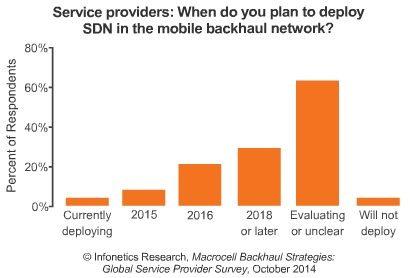 アナリストノート
「モバイル通信用ネットワークは、スモールセル、DAS (分散型アンテナシステム)、RRH (遠隔地分離型無線装置)、それにWiFiなどの新技術を取り入れて発展を続けており、マクロセル・レイヤーはトラフィックの処理には依然大きな役割を担っているものの、これらすべてを背後で結び付けるバックホール回線網はますます複雑になってきている。」 とInfonetics Research社のモバイル・バックホールおよびスモールセル担当の取締役アナリスト、Richard Webbは語る。「弊社のマクロセル・バックホールに関する調査により、通信事業者がバックホールの柔軟性を高めコストを節約するために、どの程度SDN (ソフトウェア制御型ネットワーク) やNFV (ネットワーク機能のバーチャル化技術) に注目しているかが明らかになった。」
マクロセル・バックホールに関する主要な調査結果
アナリストノート
「モバイル通信用ネットワークは、スモールセル、DAS (分散型アンテナシステム)、RRH (遠隔地分離型無線装置)、それにWiFiなどの新技術を取り入れて発展を続けており、マクロセル・レイヤーはトラフィックの処理には依然大きな役割を担っているものの、これらすべてを背後で結び付けるバックホール回線網はますます複雑になってきている。」 とInfonetics Research社のモバイル・バックホールおよびスモールセル担当の取締役アナリスト、Richard Webbは語る。「弊社のマクロセル・バックホールに関する調査により、通信事業者がバックホールの柔軟性を高めコストを節約するために、どの程度SDN (ソフトウェア制御型ネットワーク) やNFV (ネットワーク機能のバーチャル化技術) に注目しているかが明らかになった。」
マクロセル・バックホールに関する主要な調査結果
- Infonetics社の調査に回答を寄せた通信事業者はスモールセルをこれから拡大していくしていくところであり、2018年までには全トラフィックの20%以上でマクロネットワークからスモールセルへの配置換えが進むと予測している。
- バックホール回線網へのSDN (ソフトウェア制御型ネットワーク) の導入時期を聞いた所、回答者の29%がSDNの配置を既に進めているか近い将来に計画中と答えたが、大多数 (63%) は選択肢の一つとして検討はしているものの具体的な日程には上がっていない、と答えた。
- この調査の回答者の中では、マクロセル・バックホール回線網には2016年までは光ファイバー上のイーサネット技術が最もよく使われ、その後にイーサネット専用無線技術が続く。
- サービス内容契約 (SLA) で定められている諸性能のうちでは下り回線の処理能力 が最優先事項であり、調査対象の通信事業者のうち92%がこれを非常に重要と答えた。これに続くのは、ジッター、レイテンシー、上り回線バンド幅である。
- 本調査への回答者たちは、強力なマクロセル・バックホール用製品を探し求める一方で、将来にわたって使い続けることのできる全体的で柔軟度の高いネットワークを作るという戦略の助けになるようなパートナーも探している。
Mobile operators evaluating SDN and NFV for more flexible and cost-effective backhaul London, UK, October 14, 2014-Market research firm Infonetics Research released excerpts from its 2014 Macrocell Backhaul Strategies: Global Service Provider Survey, which provides insights into operator plans for macrocell backhaul. ANALYST NOTE "The mobile network is evolving to incorporate small cells, distributed antenna systems (DASs), remote radio heads (RRHs), and WiFi, and though the macrocell layer still does the heavy lifting when it comes to traffic handling, the backhaul network behind all this is becoming increasingly complex," notes Richard Webb, directing analyst for mobile backhaul and small cells at Infonetics Research. "Our macrocell backhaul study reveals the extent to which operators are looking at software-defined networking (SDN) and network functions virtualization (NFV) solutions to provide greater backhaul flexibility and cost-savings." MACROCELL BACKHAUL SURVEY HIGHLIGHTS
- Infonetics' survey respondents have yet to scale their small cell deployments, but anticipate they will place over 20% of traffic from the macro network onto small cells by 2018
- When asked if or when they will introduce software-defined networking (SDN) into the backhaul network, 29% of respondents say they are deploying or plan to deploy SDN at some point, while the majority (63%) are evaluating it as a possibility with no set timeframe
- Among those surveyed, Ethernet on fiber will be the most-used technology for macrocell backhaul connections by 2016, followed by Ethernet-only microwave
- Downstream bandwidth is the top-ranked service-level agreement (SLA) metric, rated very important by 92% of operators surveyed, followed by jitter, latency, and upstream bandwidth
- Survey respondents not only seek vendors with strong macrocell backhaul product portfolios, but partners who can also support their strategies for holistic, flexible future-proofed networks

